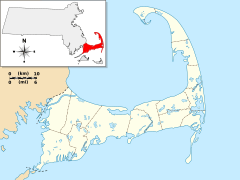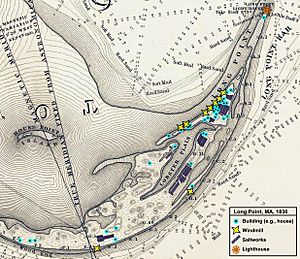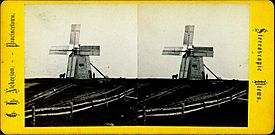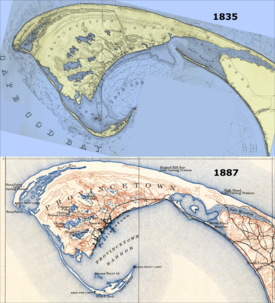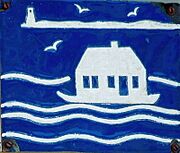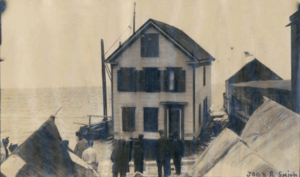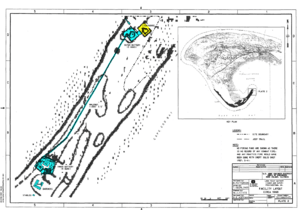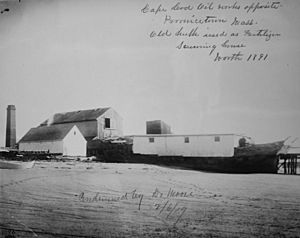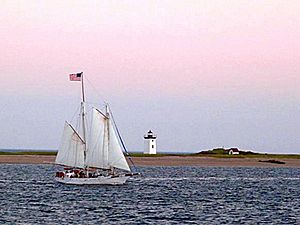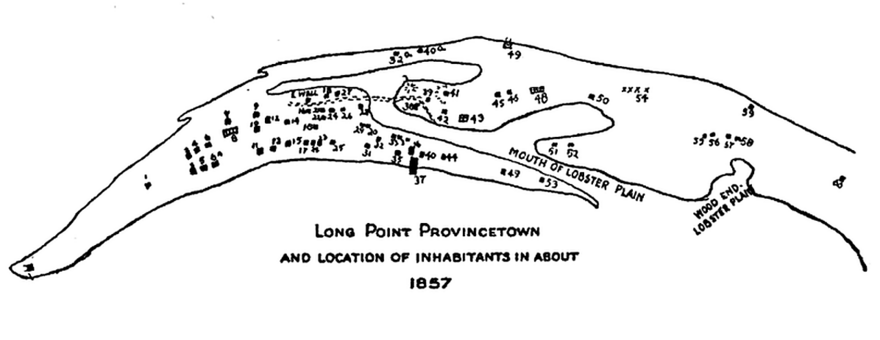Long Point (Cape Cod) facts for kids
Quick facts for kids
Long Point
|
|
|---|---|
|
Village
|
|

Long Point Light and remains of a Civil War artillery battery. Also shown is the Darby cross erected by the Beachcombers club.
|
|
| Country | United States |
| State | Massachusetts |
| County | Barnstable |
| Town | Provincetown |
| Village settled | 1818 |
| Lighthouse built | 1827 |
| Village disbanded | circa 1857–1863 |
| Battery built | 1863 |
| Battery abandoned | 1872 |
| Area
(roughly 150 acres)
|
|
| • Total | 0.2 sq mi (0.6 km2) |
| Highest elevation | 24 ft (7 m) |
| Lowest elevation | 0 ft (0 m) |
| Population
(1850)
|
|
| • Total | 260 |
| • Density | 1,120/sq mi (430/km2) |
| • Current pop. | 0 |
| Time zone | UTC-5 (Eastern (EST)) |
| • Summer (DST) | UTC-4 (E. Daylight (EDT)) |
| GNIS feature ID | 616615 |
Long Point is a narrow piece of land, called a peninsula, located in Provincetown, Massachusetts. It's right at the very tip of Cape Cod, where the land curves back to form Provincetown Harbor. The famous Long Point Light (a lighthouse) was built here in 1827.
This peninsula was once home to a small village of fishermen, also known as Long Point, Massachusetts. This village in Provincetown grew and did well from 1818 until the late 1850s. When the people decided to leave Long Point, they did something amazing: they moved most of their houses – about 30 buildings – by floating them across the harbor!
During the American Civil War, the military set up a defensive coastal artillery post (a place with big guns to protect the coast) and a garrison (a group of soldiers) here. This Long Point Battery was nicknamed "Fort Useless" and "Fort Ridiculous" by the local people.
Today, you won't find any signs of the old village, except for the lighthouse and a small dirt mound. This mound is the last bit left from the military post.
Contents
Early Days of Long Point
A fisherman named John Atwood built the first house on Long Point in 1818. Soon, more people like Prince Freeman and Eldridge Smith joined him. The community grew, and in 1822, Prince Freeman, Jr. became the first child born on "The Point," as locals called it.
Why Fishermen Loved Long Point
Fishermen were drawn to Long Point because it was very close to excellent fishing spots. They could catch lots of fish right from the shore! They used large nets called sweep seines, which their wives often hand-knitted. They caught plenty of mackerel, shad, and bass. There are stories of catching huge amounts of white shad in just one try, which brought in a lot of money back then.
Building the Lighthouse and School
In 1826, the government set aside money to buy four acres at the tip of Long Point and build a lighthouse. This lighthouse was finished in 1827. By 1830, the lighthouse became the site of Long Point's first school, starting with only three children.
The Long Point community kept growing. By 1846, the town of Provincetown decided to build a proper schoolhouse on Long Point. At that time, the village had 38 fishing families, with almost 200 adults and 60 children. Living on Long Point in the early 1800s was exciting. One writer said:
It was an exciting neighborhood to live in. Children who might have been afraid of dogs elsewhere, here ran from the sharks.
The village had its own post office, a bakery, and boat docks for 20 cod-fishing boats. It also had breakwaters (walls built to protect the shore) and several saltworks. These saltworks used nine windmills to pump seawater into large drying pans. Making sea salt was very profitable in the early 1800s because it was cheap and there was an endless supply of seawater.
Salt was not only shipped out for people to use at home, but it was also used by the fishing industry. Fishermen would dry and salt their catch to preserve the fish for shipping. The saltworks on Long Point produced a lot of high-quality salt each year.
Challenges of Life on Long Point
Making salt didn't stay profitable for long. The price of salt dropped because of new competition. When the Erie Canal was finished in 1830, it allowed companies to easily transport salt from huge salt deposits in Syracuse, New York. Also, there was more local competition, with 78 saltworks in Provincetown by 1837. The price of salt fell a lot.
Around the same time, people started wanting less salt-cured fish. They preferred fresh fish, which was kept cool with ice harvesting and storage. John Atwood Jr., whose father founded Long Point, was one of the first to bring fresh mackerel on ice to Boston in 1848. He even found ways to make his boat faster to get the fresh fish to market quickly.
Living on Long Point also had its own difficulties. Provincetown itself was quite isolated for a long time. It was surrounded by water:
- The Atlantic Ocean to the north.
- Massachusetts Bay to the northwest.
- Cape Cod Bay to the west and southwest.
- Provincetown Harbor to the south and southeast.
- East Harbor and a salt marsh to the east.
Until the late 1800s, there was no road connecting Provincetown to the rest of Cape Cod. The only way to travel by land was to go north over tall sand dunes and then follow a thin strip of beach. A wooden bridge was built over the East Harbor in 1854, but storms often destroyed it. Before the railroad arrived in 1873, Provincetown was like an island, relying mostly on the sea for travel and trade. Long Point was even more isolated from the main town of Provincetown. To get to town from Long Point by land, you had to walk about 3 miles (4.8 km) across a beach and then another mile (1.6 km) over shifting sand dunes. Parts of this route would even be underwater during high tide!
Another big challenge was fresh water. There was no natural source of fresh water on Long Point. People built large wooden tanks called cisterns to collect and store rainwater. During dry periods, they had to fill barrels with water in Provincetown and bring them over to the point.
Besides droughts, the residents of Long Point also faced the threat of powerful storms. While Long Point protects Provincetown and its harbor from many storms, the point itself takes the full force of these storms.
This sickle of sand which encloses one of the finest harbors on the North Atlantic was so narrow that encroaching storms played havoc with it and threatened at one time to sweep the narrow point away. It was too valuable a harbor to be destroyed and the government took it over.
The Great House Move
It's not entirely clear why people left Long Point, or if there was one big event that made everyone leave at once. However, everyone agrees that starting in the 1850s, families began to move from Long Point back to the main town.
Most families took their houses with them! A local Deacon was skilled at moving buildings. The houses, about 30 in total, were placed on rafts and floated across Provincetown Harbor to the town's West End. It's said that the houses were moved so gently that "the moving didn't interfere with the housewife cooking her dinner," according to Mary Heaton Vorse. By the time of the American Civil War (1861–1865), only two houses were left on Long Point.
A newspaper article from 1942 shared another version of the story:
Perhaps the inhabitants grew tired of sharks sunning themselves on their front lawns, perhaps sea creatures carried off their pet dogs and cats; whatever the reason the citizens of Long Point scheduled a colossal moving day. The women packed the household possessions in dories, while the men floated the houses and public buildings across a mile of water on casks. And that was the end of the community of Long Point.
Many of these historic "floater homes" are still standing in Provincetown's West End today. You can spot them by a special blue and white plaque that tells the story of their journey. The schoolhouse was one of the last buildings to leave Long Point. It was moved to Commercial Street in the center of town.
Long Point Battery: "Fort Useless"
During the War of 1812, the British navy controlled Provincetown Harbor. To fix this lack of defense, the U.S. Army looked at the harbor in the 1830s and noted that Long Point had many civilians living there.
The Army returned to build the Long Point Battery during the American Civil War. Army records say that the point was empty by the time they started building two dirt artillery batteries (places for cannons) in early 1863. Construction finished in December 1863.
Battery Structure and Soldiers
The outer battery had three large 32-pounder guns and a built-in powder magazine (where gunpowder was stored). The inner battery was connected to the outer one by a 1,650-foot (500 m) wooden walkway. It had six 32-pounder guns and two built-in magazines. A barracks (building for soldiers) and officers' quarters were built south of the inner battery.
Major Charles E. Blunt of the United States Army Corps of Engineers designed and supervised the building of these batteries. Interestingly, the Army didn't build new officers' quarters. Instead, the company's three officers lived in the last remaining house from the old village.
In 1864, the state of Massachusetts gave about 150 acres (0.6 km²) of Long Point to the United States Government. The new barracks housed 98 soldiers from the Massachusetts Volunteer Militia. These soldiers served several tours of duty at the post. They were released from service in June 1865 when the war ended. The soldiers' barracks was floated across the harbor after the war and is now a building at 473 Commercial Street in Provincetown.
The batteries on Long Point were ready for use until 1872, but they were never actually used in a real battle. After the war, the people of Provincetown knew they were safe from an enemy that never appeared. They soon started calling the batteries "Fort Useless" and "Fort Ridiculous." Today, the dirt mounds of the batteries are still there, but they look just like sand dunes.
Long Point Today

In 1873, an inspection showed that the original wooden lighthouse was in very bad shape. It was so weak that a strong storm might destroy it. So, in 1875, that lighthouse was replaced with the brick tower you see today.
Even though the Army left, they still owned the land. Around the time the lighthouse was rebuilt, the Cape Cod Oil Works built a factory there. This factory made cod fish oil and whale oil in the area where the barracks used to be. Since the land was still a military area, the Army tried to get the factory removed many times. Records from this time are hard to find, but Army files show the factory was still running in 1883. Another source from 1890 says that the Cape Cod Oil Works used a wharf built by John Atwood, and that these were the only buildings left besides the lighthouse. We don't know exactly when the factory closed, but Army letters in 1917 don't mention it. The only known photo of the factory, taken in 1891, has "Condemned ... 1919" written on it.
An oil house was built in 1904 to safely store the flammable materials used for the lighthouse light. Besides the lighthouse and this oil house, no other buildings from the past remain today. The dirt mound that was once the outer battery now looks just like a sand dune. You won't find any other hints of the old village, the military post, or the oil factory on Long Point today.
One special item you can see on top of the outer battery's earthworks is a cross. It honors Staff Sgt. Charles Darby, a soldier who loved the dunes and was killed in action over the Netherlands in 1944.
Village Layout in 1857
The image below shows how the houses, stores, and saltworks were arranged on Long Point in 1857. If you click on the image, you'll see a larger view and a key explaining what each number means. This list, which includes the names of each home or store owner, gives you a good idea of how big the community was back then.
Gallery
-
Present-day map of Long Point, from the National Park Service.
-
The original lighthouse and keeper's house. Note the three small children seated in front.


